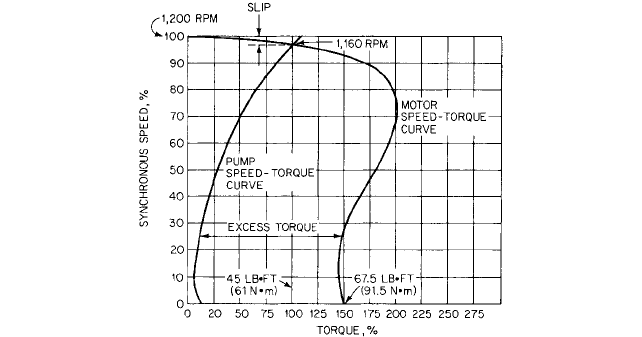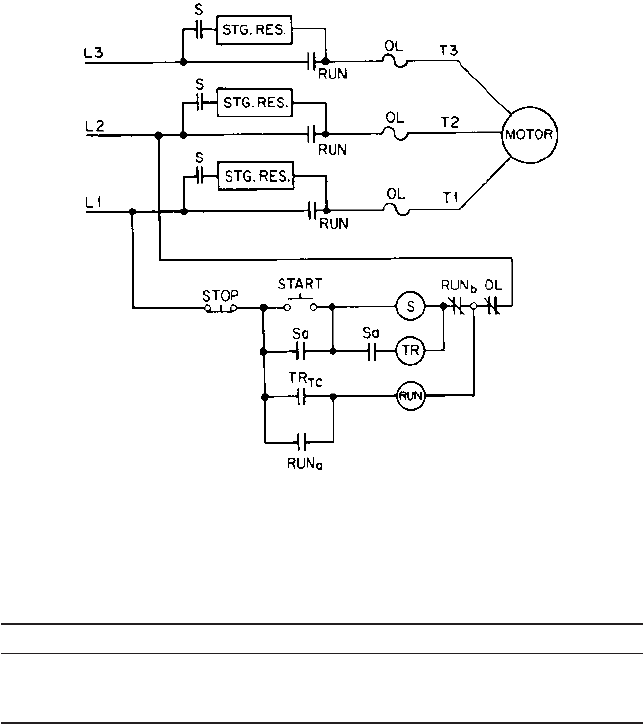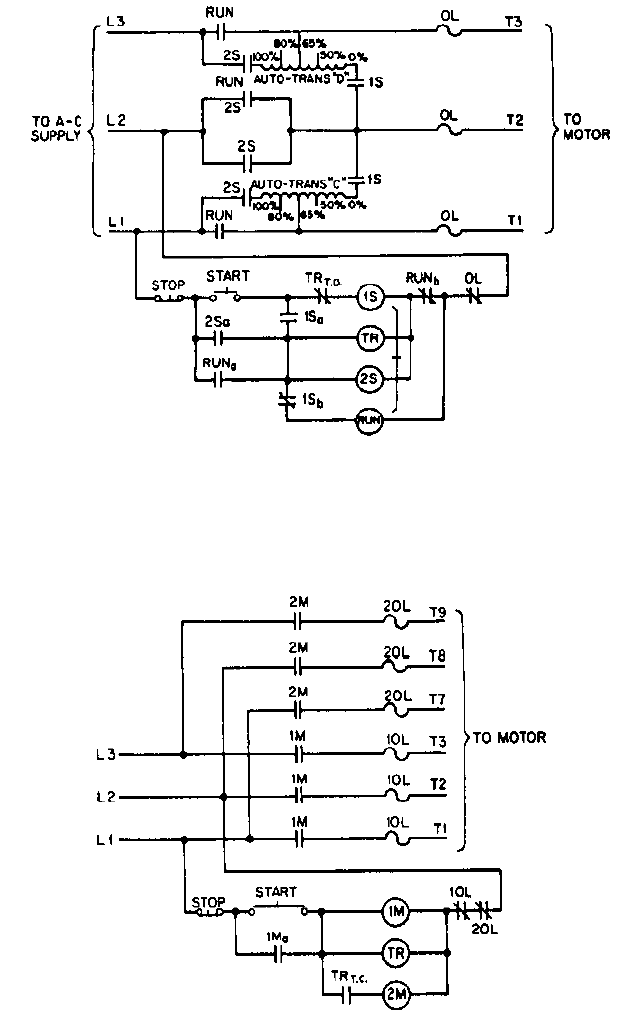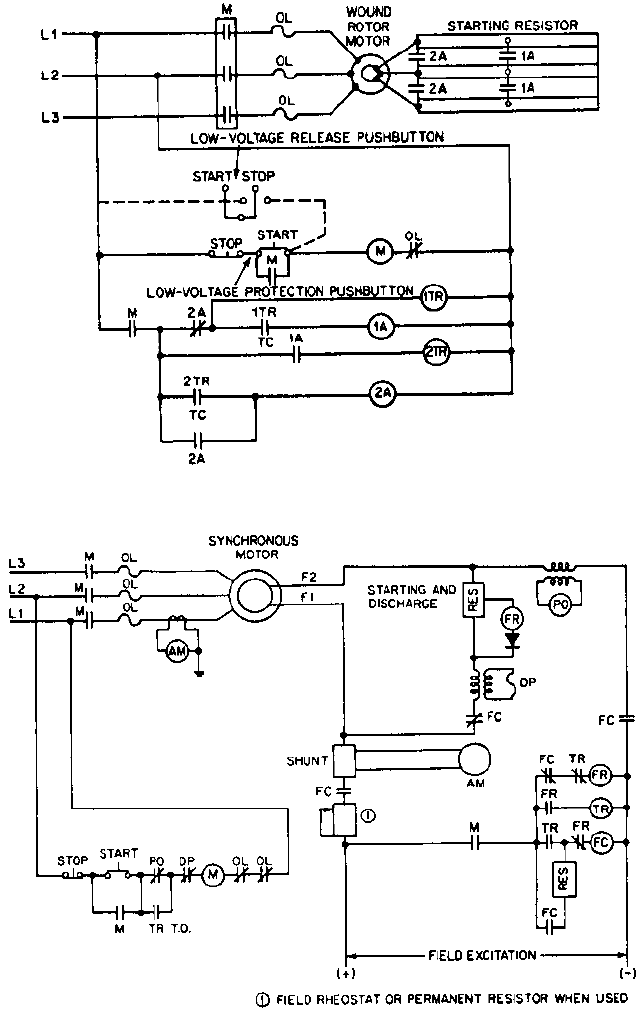Pump Handbook by Igor J. Karassik, Joseph P. Messina, Paul Cooper, Charles C. Heald - 3rd edition
Подождите немного. Документ загружается.

6.22 CHAPTER SIX
speed, ambient temperature, and frequency. If the operating conditions are different from
the nameplate ratings, the motor performance will be altered. Many of the newer PM and
SR brushless motors are designed to produce their rated output power over a wide speed
range. A high efficiency ac induction motor can also perform similarly if a Flux Vector
Inverter is used for control.
Voltage Ac motors are designed to operate satisfactorily at their nameplate voltage rat-
ing with a ;10% variation from nameplate voltage when operating at rated nameplate
frequency. This dictates that the motor will develop rated power and speed to a pump and
will operate at a safe insulation temperature over the range of voltage. The motor torque
will vary directly with the square of the applied voltage divided by the nameplate volt-
age.This affects the peak torque of the motor and will cause the motor speed-torque curve
as shown in Figure 2 to be altered.Within the ;10% voltage band, a motor can be expected
to accelerate and operate a pump safely and continuously. A motor should never be
expected to operate continuously beyond the ;10% band. If the voltage varies more than
;10%, the pump and motor may not operate satisfactorily.
For example, assume a pump is operated by a NEMA design B motor (refer to Figure
2) that will produce 200% pull-out torque at rated voltage. If the line voltage were to fall
to 70% of the rated name-plate voltage, the motor would produce only 49% of its peak
torque value. The pull-out torque of the motor would then become 0.49 200 98% of
rated torque. It then becomes very doubtful whether the motor will be able to sustain the
pump load, and the motor can be expected to lose speed, stall, or become overloaded. Cer-
tainly, it will also heat up, which will shorten the expected life of the bearing lubrication
and winding insulation system.
In a similar sense, a motor may be unable to accelerate a pump if low line voltage
exists. In the example previously discussed, this same motor develops 150% of rated
torque when started at zero speed and rated voltage. If the line voltage is again 70% of
nameplate voltage, the motor will develop 0.49 150 73% of rated torque. This may be
a problem with certain types of pumps, such as a constant displacement pump. It is con-
ceivable that this would not be a problem in starting a centrifugal pump because of its
square-law speed-torque characteristics. If the motor voltage never increased beyond 70%,
the centrifugal pump would not reach normal operating speed. An exception to this rule is
the commutating ac motor, for which a ;6% voltage variation is allowable.
Varying motor voltage from nameplate rated voltage will also affect the motor operat-
ing speed, power factor, and efficiency established for rated voltage and load. Most
polyphase ac induction motors will operate at several rpm faster than nameplate speed at
10% over voltage and several rpm below nameplate speed at 10% under voltage. The
speed of a synchronous motor is determined by the line frequency of the alternating volt-
age not the voltage level. Therefore, voltage variation has no effect on the speed of a syn-
chronous motor. However, voltage variation does effect maximum torque output of a
synchronous motor.
Dc motors can also be operated over a ;10% voltage range from nameplate rated volt-
age. However, it should be recognized that different types of dc motors will have different
speed and torque characteristics over the voltage range.This should be taken into account
when meeting pump performance requirements.
One of the most common applications for dc motors has been for metering pumps
because of their ease of setting the speed to precisely meter the fluid being pumped.
Although a voltage variation would change the pump speed, it is customary to include a
speed control loop with the dc supply to maintain constant speed in spite of line voltage
variations.
Frequency Ac induction motors will operate satisfactorily at rated load and voltage
with a frequency variation up to 5% from rated nameplate frequency. However, the speed
of the motor will vary almost directly with the line frequency. The speed of a synchronous
motor will vary directly with applied frequency. The combined variation of voltage and fre-
quency must not be more than 10% from rated nameplate voltage and frequency, pro-
vided the frequency variation does not exceed 5% from rated nameplate frequency. The
reason is that frequency variation from the nameplate frequency will cause motors to

6.1.1 ELECTRIC MOTORS AND MOTOR CONTROLS 6.23
FIGURE 19 Typical speed-torque characteristic curves for a centrifugal pump and a squirrel-cage induction,
NEMA design B motor. Excess torque accelerates pump.
operate at a power factor and efficiency other than those established for rated frequency.
Any electric motor such as PM or SR brushless and even ac induction, which is powered
from an inverter, is unaffected by frequency variations.
Speed and Speed Range Synchronous and induction motors were originally expected
to be operated at one specific speed when powered from line voltage and frequency. How-
ever, with the availability of inverters, this is no longer the case. In fact, the use of invert-
ers for driving induction motors is expanding at a fast pace as the merits and benefits of
adjustable speed are being realized. The use of speed controlled PM and SR brushless
motors along with their inverters and controllers allow the pump application to take
advantage of the usefulness of adjustable speed. Using the inverter with any of these types
of motors eliminates any difficulties from speed variations from the past. This is because
most inverters have a speed control loop that will automatically maintain the set speed.
Acceleration A motor must be capable of accelerating as well as driving a pump at
rated speed and power. The acceleration can be analyzed by examining a typical pump-
motor combination involving a centrifugal pump driven by a six-pole squirrel-cage induc-
tion motor rated 10 hp (7.46 kW) with NEMA design B torque characteristics. The curve
in Figure 19 demonstrates this combination when the pump is loaded and the motor is
operating at nameplate frequency and voltage. It will be noted that the torque produced
by the motor at any speed must be greater than the torque required by the pump when
up to speed. The excess torque at any speed is available to accelerate the motor, coupling,
and pump rotating parts.
NEMA has provided a handbook for motion control that outlines the fundamental
equations for the required torque calculations to accelerate any inertial loads to a prede-
termined speed. For the use of ac induction motors that are line-fed with constant voltage
and frequency, the formulas are used to calculate the time to the motor slip from synchro-
nous speed for a given total rotating inertia. For the use of inverter-fed ac induction, PM
or SR brushless motors, the formulas are used to determine the torque required to accel-
erate the total rotating inertial load to the desired speed in the desired time.
The fundamental equations for motion, which include torque, inertia, time and accel-
eration relationships, are given below. They can be used for motor selection analysis for
pumps. For example, if the torque available from an induction motor is known, the equa-
tion can be solved for the acceleration time of the system inertia (from NEMA “Program-
mable Motion Control Handbook”).

6.24 CHAPTER SIX
: Total torque = Acceleration torque constant torque
: Acceleration torque = Inertia Angular acceleration
: Angular acceleration = Max RPM/acceleration time
= Torque from all other constant forces, friction, windage, preload, and so on.
NOTE:
Use consistent units depending on whether U.S. Customary or SI.
The time to accelerate the pump is equal to
in USCS units
in SI units
where t time, s
WK
2
total weight (force) moment of inertia, lb ft
2
rpm change in speed
T torque, lb ft (N m)
MK
2
total mass moment of inertia, kg m
Because the difference in torque is not uniform over the speed range, the curve (Figure
19) can be analyzed by assuming discrete changes in speed and an average torque over
this change in speed. A time period can be calculated for each discrete speed change, and
all time values can be totaled to obtain the complete acceleration time.
Increasing the inertia of the pump, the operating speed of the pump and motor, or the
torque required by the pump at any speed will result in a longer acceleration time, which
may not be possible for the motor. Each motor can operate at a reduced speed and at a
torque in excess of rated torque for a given time. Beyond this time, the windings and/or
rotor can be damaged. The use of an inverter-driven ac induction SR or PM brushless
motor eliminates all of these problems associated with the use of line-fed ac induction
motors. This is due to the torque control capability of the inverter/motor drive system
using current control. The limit on the ability of the adjustable speed drive to control accel-
eration is a function of the current capability of the inverter (as long as the thermal limit
of the motor has not been exceeded).
When an application is analyzed and found to present an acceleration-time problem,
consideration should be given to
1. Unloading the pump during acceleration
2. Reducing the inertia of the rotating parts
3. Selecting a larger motor
4. Considering an adjustable speed motor and drive
When very large pumps are started, the line voltage will sometimes drop because of the
high starting current, which causes the motor torque to be reduced by the square of the
voltage ratio. Naturally, the acceleration time is greater because of the reduced torque pro-
duced by the motor. This will not hamper the ability of the motor to accelerate the pump
as long as the motor develops more torque than is required to drive the pump at any speed
over the accelerating range. The use of SR or PM brushless induction motors eliminates
this problem because these motors do not draw high inrush currents. In fact, the starting
current is controlled very precisely.
A similar analysis can be made for synchronous motors after the accelerating speed-
torque curve for the motor is known. It should be recognized that a synchronous motor
operates as a squirrel-cage induction motor up to the moment of synchronization. At that
time, the synchronous motor must have an additional capability of synchronizing torque,
t
MK
2
¢rpm
9.55T
t
WK
2
¢rpm
308T
T
C
a
v
max
t
a
2p
T
A
J
TOTAL
a
T
TOTAL
T
A
T
C

6.1.1 ELECTRIC MOTORS AND MOTOR CONTROLS 6.25
frequently called pull-in torque, to accelerate the motor from subsynchronous to synchro-
nous speed. If the motor cannot develop enough torque at its synchronous speed, it will pull
out or stall. When this type of motor is used for a pump, it is advisable to unload the pump
during acceleration operation to reduce the torque required from the motor for acceleration.
When using a synchronous motor, attention should always be given to the breakaway
torque that is required to start the pump from zero speed. This is particularly important
with constant displacement pumps, where the pump will operate at a constant torque over
the entire accelerating speed range. Again, a better selection might be an inverter-driven
ac induction motor, SR or a PM brushless motor.
Service Factor Motors are available with service factor ratings that range from 1.0 to
as high as 1.5. A service factor implies that a motor has a built-in thermal capacity to oper-
ate at the nameplate power times the service factor stamped on the nameplate. It should
be noted, however, that when the motor is operated at the service factor power, the motor
will operate at what is termed a safe temperature. This means that the motor will oper-
ate at a total temperature that is greater than the temperature for a motor designed for
the same power with a 1.0 service factor. Consequently, it is not advisable to apply a motor
with a service factor larger than 1.0 where the continuous power requirements will be
greater than the normal power.
A service factor rating on a motor is to provide an increased power capacity beyond
nominal nameplate capacity for occasional overload conditions. Also, the speed-torque
characteristics are related to the nominal power rating and not the service factor power.
When adjustable speed motor/drive systems are selected, the old service factor ratings are
not useful. The supplier of the drive system will assist in selecting a thermally rated sys-
tem that will satisfy the pumping operation. All inverters are equipped with thermal
safety protection for both the motor and the drive so the system cannot be overloaded to
minimize overheating. This is a very useful feature for many pump applications.
Efficiency Motors are designed to operate with an efficiency expressed in percent at
rated voltage, frequency, and power. Efficiency is defined as
The efficiency of a given motor design will vary slightly from unit to unit because of
manufacturing tolerances and variations in materials. For this reason, guaranteed effi-
ciencies are usually lower than actual efficiencies. When motors are operated at
reduced powers, the tendency is for the efficiency to decrease because the losses tend to
be fixed.
Several other factors have an effect on motor efficiency. Increasing the applied voltage
and operating a motor at its rated power will increase efficiency very slightly, whereas
decreasing applied voltage will decrease the efficiency noticeably. Also, increasing the fre-
quency will cause a very slight increase in efficiency, and decreasing the applied frequency
will cause a slight decrease in efficiency.
Inverter-fed ac induction and PM or SR brushless motors are not subject to changes in
their efficiencies due to changes in line voltage or frequency because the ac line voltage is
rectified into a dc voltage before the regeneration of the power to the motor. The dc volt-
age is always reasonably constant and unaffected by changes in the line power. This of
course assumes that there is sufficient voltage and power headroom in the design.
Dynamometers are used to determine efficiency for small motor ratings
—
up to approx-
imately 500 hp (373 kW)
—
and standard methods and formulas are used for calculating
efficiency for large motors. For the latter, efficiency values can vary, depending upon which
“standard” procedure is used. Several suppliers market torque and power analyzers for
induction motors that base their output on these formulas using current data measured
from the motor. These methods are accurate enough to be acceptable. They have been rea-
sonably verified by applying the method to smaller motors that have been tested on a
Efficiency %
shaft output power 100
electrical input power

6.26 CHAPTER SIX
Condition Effect on power factor
Increase applied voltage Decrease
Decrease applied voltage Increase
Increase load Increase
Decrease load Decrease
Increase applied frequency Slight increase
Decrease applied frequency Slight increase
dynamometer. NEMA has established one method, but some suppliers use different meth-
ods, depending upon their national standards or established practices.
Higher efficiencies have been designed into most new motors by selecting materials
and proportions that reduce losses, but such design choices usually make the motor more
costly. This also includes filling the stator slots with more copper of a larger wire gage to
reduce ohmic losses.These new motors designed for higher efficiencies offer improvements
from 2% to as high as 7% depending upon the size and manufacturer.
Motor operating efficiency in a typical application often may not be that described by
the manufacturer. Quoted efficiencies are always at rated power output, rated frequency,
and rated voltage. However, it is almost universal in application that a motor is oversized
for its applied load and frequently operates at other-than-normal voltage. Both of these
variables can greatly reduce the efficiency of a motor. However, when a motor is inverter-
driven, the efficiency of the system can be much better controlled.
Power Factor The power factor of a motor is expressed as
where u is the angle between voltage and current at motor terminals (leading or lagging).
The power factor at which a motor operates is dependent on the design of the motor
and is established at rated voltage, frequency, and power output.
For induction motors, the power factor can never be 100% leading.A number of factors
will influence the power factor of an induction motor:
PF 100 cos u
In synchronous motors, it is usual to use two varieties of motors, the 100 (unity) and
80% leading motors. The power factor of a synchronous motor operated at rated voltage
and frequency is fixed by its field excitation and its power output. At a given power out-
put, the power factor can be adjusted over a range by adjusting the field excitation.
Increasing the field excitation will cause the motor to operate at a more leading power fac-
tor, and, conversely, reducing the field excitation will make the power factor lag.
Varying the power output of a synchronous motor with a constant field excitation will
vary the operating power factor. A decrease in power output will cause a more leading
power factor; conversely, increasing the power output will induce operation at a lagging
power factor. Consequently, to operate the motor at rated power factor with a varying out-
put power, it is necessary to adjust the field excitation. However, this is not normally done
because a synchronous motor is frequently used for improving the power factor and the
more leading power factor is used to accommodate power factor improvement. When a
synchronous motor is overloaded and operates at a more lagging power factor, it is not
usual to increase the excitation beyond its rated excitation because of the extra heating
this will develop in the motor. In this case, the more lagging power factor is simply
accepted.
The power factor is not of much concern for SR and PM brushless motors driven by
inverters because of the control capabilities for these systems. The PM machine exhibits
the best power factor of any known motor under nearly all operating speeds and power lev-
els except if excessive field weakening or phase advance is used.
6.1.1 ELECTRIC MOTORS AND MOTOR CONTROLS 6.27
TYPES OF CONTROLS ________________________________________________
In order to use an electric motor to drive a pump, a means of starting and stopping the
motor is required. The devices used for this purpose can be called controls. Only small
—
perhaps up to two or three hp (kW)
—
motors can be controlled with a simple on-off switch
(starting from full rated line voltage). This is because when a motor is first started it pro-
duces no back EMF and will draw very high starting currents. If the load inertia is very
high, the motor can overheat during the long acceleration time. In addition, the high start-
ing current peaks can cause heavy dips in the line voltage. Therefore, for larger motors,
these line voltage dips must be minimized by the use of starters.There are four basic ways
to start ac induction motors:
1. Direct online starting
2. Low voltage starting
3. Rotor resistance starting
4. Low frequency starting
Other devices used to control motors such as soft starters, adjustable frequency controls,
and vector drives are discussed along with the inverters and controls for other motor types
such as dc motors, SR and PM brushless in Subsection 6.2.2.
Alternating-Current Motor Starters
MANUAL STARTERS
Manual motor starters are designed to provide positive overload pro-
tection and start and stop control of single-phase and polyphase motors up to about 3 HP
(2.5 kW). A single manual toggle switch or a push button switch is used for “on,”“off,” and
“tripped” states. These types of starters use full line voltage applied to the motor.
MAGNETIC STARTERS Magnetic motor starters cost more and are more reliable than man-
ual starters. They are designed to control a motor by incorporating a magnetically oper-
ated contactor to apply power to the motor terminals rather than allowing full current to
pass through the contacts.
An overload relay is incorporated to protect the motor from overloading. Magnetic
starters are available for reversing and nonreversing service and are also made as non-
combination or combination types. The non-combination starter combines only the motor
contactor and overload relay. The combination starter combines these parts along with
either a circuit breaker or a fused switch to provide shortcircuit protection.
REDUCED-VOLTAGE STARTERS Reduced-voltage starters are available in several types and
are basically magnetic starters with additional features to provide reduced voltage, which
in turn provides for reduced motor-starting current or torque. These starters include the
types discussed in the following paragraphs.
Primary-Resistor Starters Primary-resistor starters, sometimes known as cushion-type
starters, will reduce the motor torque and starting inrush current to produce a smooth,
cushioned acceleration with closed transition. Although not as efficient as other methods
of reduced-voltage starting, primary-resistor starters are ideally suited to applications
where reduction of starting torque is of prime consideration. A typical diagram for this
type of starter is shown in Figure 20.
Autotransformer Starters Autotransformer starters are widely used reduced-voltage
starters because of their efficiency and flexibility. All power taken from the line, except

Tap, % Starting torque, % locked torque Line inrush, % locked current
50 25 28
65 42 45
80 64 67
6.28
CHAPTER SIX
FIGURE 20 Typical primary-resistor, reduced-voltage starter wiring diagram (Westinghouse Electric)
transformer losses, is transmitted to the motor to accelerate the load. Taps on the trans-
former allow adjustment of the starting torque and inrush to meet the requirements of
most applications. The following characteristics are produced by the three voltage taps:
A typical diagram for this type of starter is shown in Figure 21.
Part-winding starting provides convenient, economical, one-step acceleration at
reduced current where the power company specifies a maximum or limits the increments
of current drawn from the line. These starters can be used with standard dual-voltage
motors on the lower voltage and with special part-winding motors designed for any volt-
age. When used with standard dual-voltage motors, it should be established that the
torque produced by the first half-winding will accelerate the load sufficiently so as not to
produce a second undesirable inrush when the second half-winding is connected to the
line. Most motors will produce a starting torque equal to between one-half and two-thirds
of NEMA standard values with half the winding energized and draw about two-thirds of
normal line-current inrush. A typical diagram is shown in Figure 22.
Star-delta starters have been applied extensively to starting motors driving high-
inertia loads with resulting long acceleration times. They are not, however, limited to this
application. When 6 or 12 lead delta-connected motors are started star-connected, approx-
imately 58% of full-line voltage is applied to each winding and the motor develops 33% of
full-voltage starting torque and draws 33% of normal locked rotor current from the line.

6.1.1 ELECTRIC MOTORS AND MOTOR CONTROLS 6.29
FIGURE 21 Typical autotransformer, reduced voltage starter wiring diagram (Westinghouse Electric)
FIGURE 22 Typical part-winding starter wiring diagram (Westinghouse Electric)

6.30 CHAPTER SIX
FIGURE 23 Typical star-delta, reduced-voltage starter wiring diagram (Westinghouse Electric)
When the motor has accelerated, it is reconnected for normal delta operation. A typical
diagram is shown in Figure 23.
Wound Rotor Motor Starters These magnetic motor starters are used for starting, accel-
erating, and controlling the speed of wound-rotor motors. The primary control includes
overload protection and low-voltage protection or low-voltage release, depending on the
type of pilot device. Disconnect switches, circuit breakers, and reversing can be added to
the primary circuit when required. Reversing starters are not designed for plugging.
The secondary circuit contains the NEMA recommended number of accelerating or
running contactors and resistors to allow approximately 150% of motor full-load torque on
first point of acceleration. Additional accelerating points can be added for high-inertia
loads or exceptionally smooth starts. Adjustable timing relays permit field adjustment.
Standard starting duty NEMA 135 resistors allow 10 s starting out of every 80 s. A typi-
cal diagram is shown in Figure 24.
Synchronous-Motor Starter Synchronous, magnetic, full-voltage starters provide reliable
automatic starting of synchronous motors. They can be used whenever full-voltage start-
ing is permissible. Automatic synchronization is provided by field relay, which assures
application of the field at the proper motor speed and at a favorable angular position of sta-
tor and rotor poles. As a result, line disturbance resulting from synchronization is reduced
and effective motor pull-in torque is increased. A typical diagram is shown in Figure 25.
Brushless synchronous-motor starters require special consideration inasmuch as all
brushless synchronous motors are not constructed in the same way. The usual starter
incorporates a low-power adjustable dc excitation source to energize and control the out-
put of an integral shaft-connected exciter.
In addition, a pull-out relay and a timing relay are incorporated to initiate synchro-
nization and stop the motor in event of pull-out.
Direct-Current Motor Starters Direct-current motor starters are designed to apply nor-
mal voltage to the motor field and, by means of a resistor, reduce voltage to the armature.

6.1.1 ELECTRIC MOTORS AND MOTOR CONTROLS 6.31
FIGURE 24 Typical wound-rotor motor starter wiring diagram (Westinghouse Electric)
FIGURE 25 Typical synchronous-motor starter wiring diagram (Westinghouse Electric)
